How to Do a SERP Analysis in 5 Easy Steps (With Examples)
Gabriela Jhean
When conducting keyword research, we often come up with dozens, if not hundreds, of keyword ideas. Some are attainable for ranking, while others may be well out of reach.
A SERP analysis will help you differentiate between keywords worth pursuing and those that are too competitive to target.
In this article, you’ll learn how to do a SERP analysis in just 5 easy steps.
Plus, we’ll share examples of specific keywords so you know what the process looks like in real-world scenarios.
Table of Contents
What Is a SERP Analysis?
A SERP analysis is a deep dive into the search engine results page (SERP) for a specific keyword or phrase.
It involves examining the top-ranking websites to understand what makes them successful and how you can compete.
By analyzing SERPs, you can identify which keywords to target, uncover the strengths and weaknesses of your competitors, and create content that resonates with your audience.
Why Is a SERP Analysis Important?
A SERP analysis is crucial for several reasons:
- Keyword Research: It helps you identify low-competition keywords that you can rank for.
- Content Strategy: You can tailor your content to match the search intent and format of the top-ranking results.
- Competitive Analysis: Understanding your competitors’ strengths and weaknesses can give you a significant advantage.
- SEO Optimization: You can optimize your website and content to improve your chances of ranking higher in search results.
How to Do a SERP Analysis
Here’s how to do a SERP analysis in just 4 steps:
1. Analyze the SERP: Find Low-Hanging Fruits
Enter your desired keyword into a keyword research tool.
For our example, I’ll be using LowFruits.
Let’s imagine I have a brand-new travel website, and search “best attractions in *” the KWFinder tool. (The asterisk is a wildcard search, meaning it tells LowFruits to look for the best attractions in somewhere.)

After analyzing some keywords (this SERP Analyzer tutorial shows you how), we get a report that looks like this:
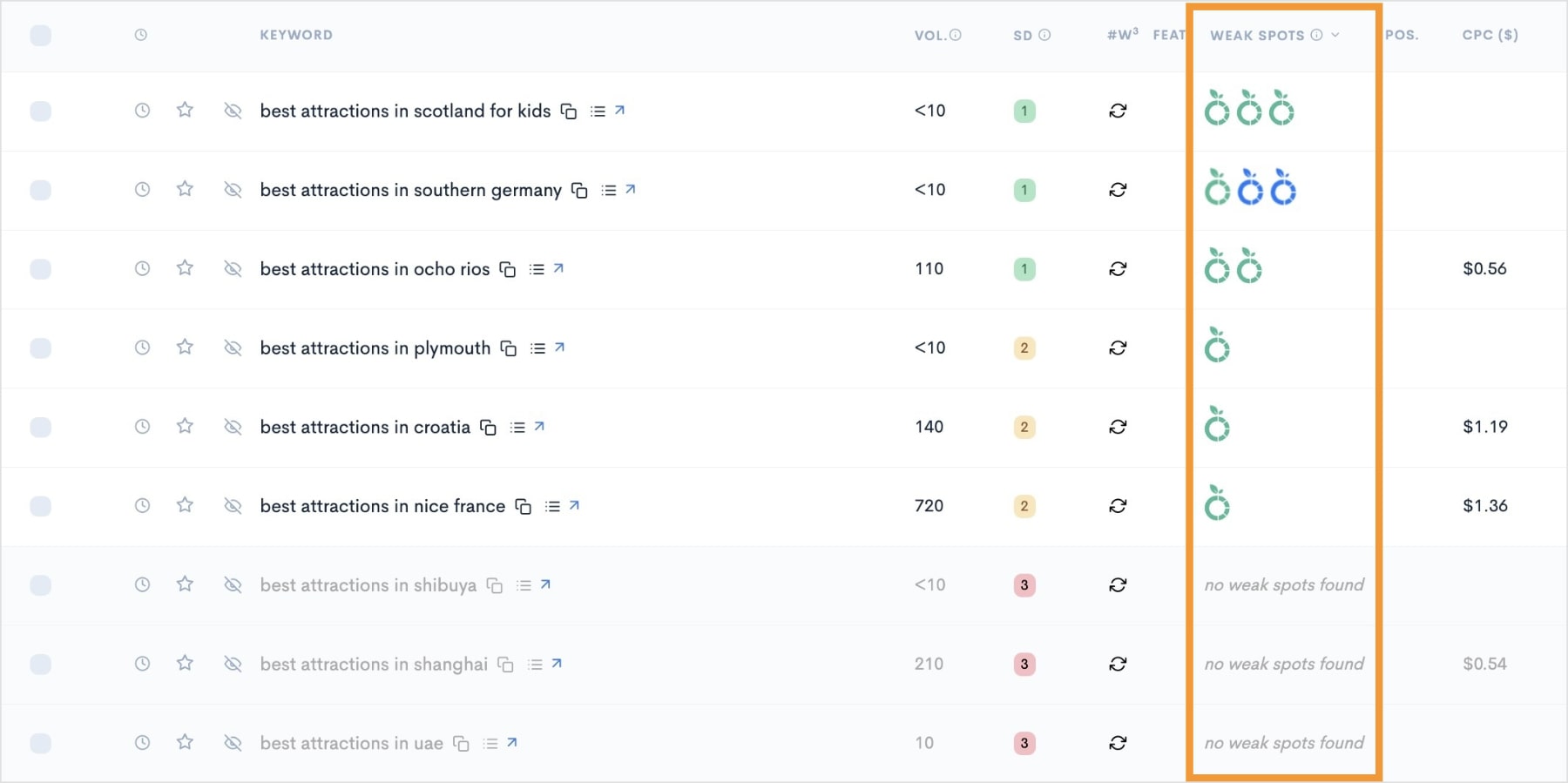
In our example, we have a few keyword ideas that we are evaluating if they are worth pursuing for our new travel website.
We can see that 6 of these keywords have green fruit icons. These are weak spots, which are domains ranking on the 1st page of Google with a domain authority (DA) below 20.
For every fruit, there is 1 website ranking on the 1st page that wouldn’t be very hard to overtake — even for a new website.
As for the blue fruits, they symbolize forum websites as well as any other user-generated content, which is usually not very hard to outrank since it’s not very optimized.
And then, there are keywords that have no fruits at all.
That means the 1st page on the SERPs has been occupied by websites that have a domain authority of over 20, meaning it will be harder to rank.
We wouldn’t necessarily want to target these keywords with our new website.
2. Assess the Content Type & Search Intent
The next step is to see what kind of content format works best.
Typical content formats include:
- Listicles
- How-To Guides
- Informational Articles
- Product Pages
Let’s view the SERP to see what type of content ranks for one of our keywords.
I’ll click the View the SERP button next to the keyword I’m interested in.
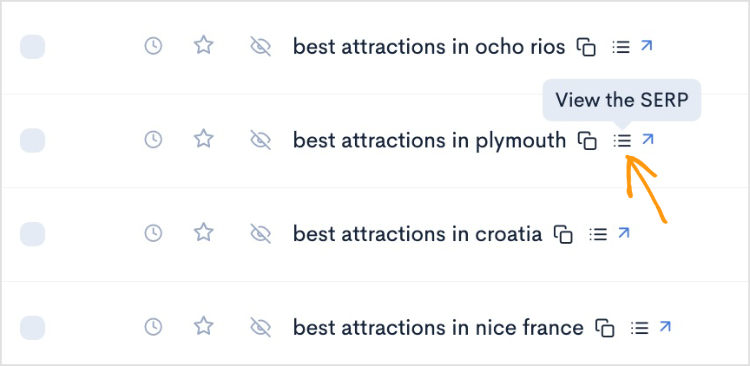
LowFruits opens a pop-out window that looks like this:
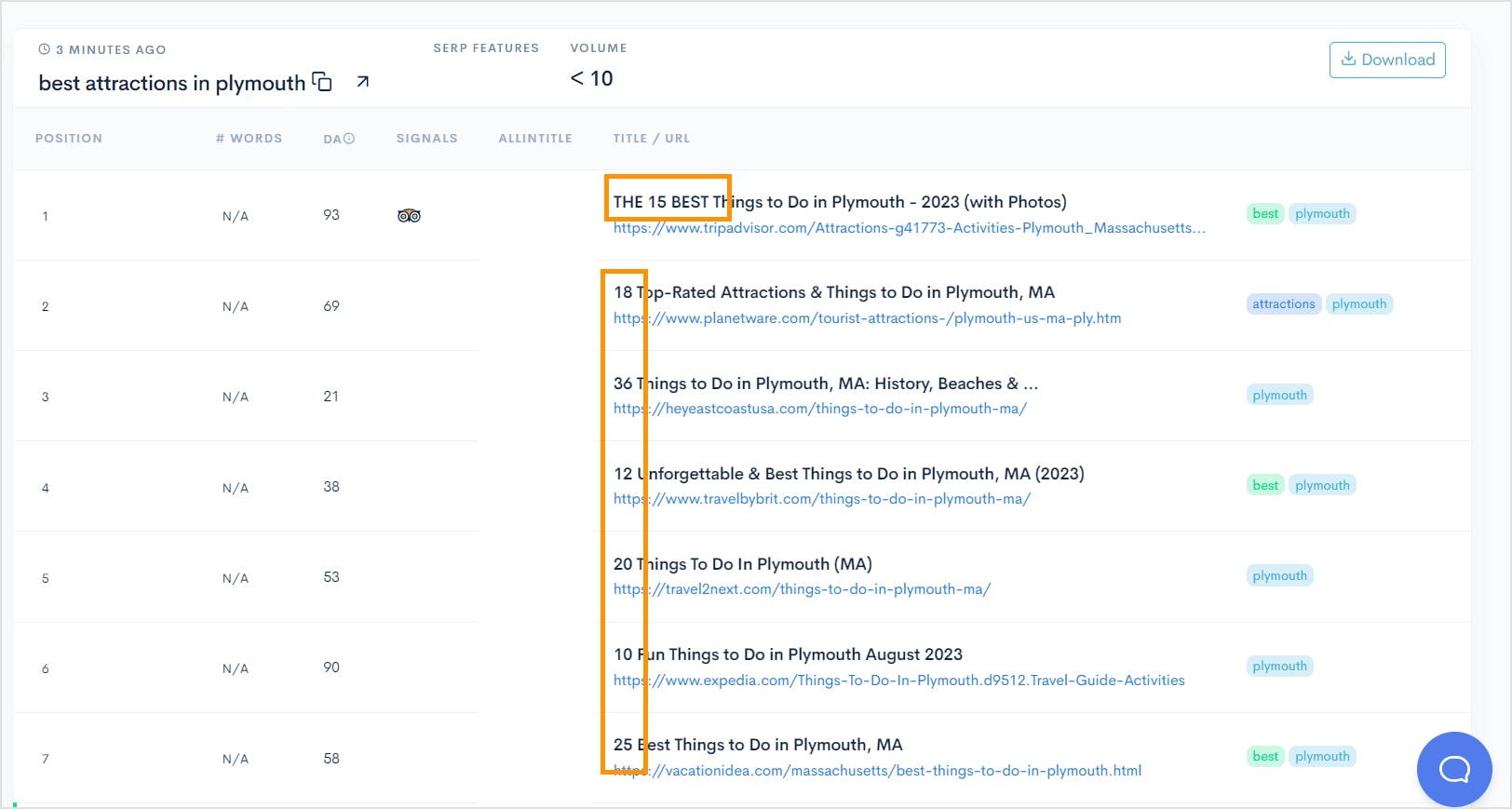
In this example, we can see that the dominant content format for our keyword is listicles.
And if listicles are the highest ranking and everyone else is doing them, chances are that Google has deemed that this content format answers the query the best.
But here’s the tricky part: There is a Plymouth in England, and a Plymouth in Massachusetts, USA.
This is why search intent matters and where the SERP analysis really pays off.
We can see that the competitors are putting in an ”MA” at the end to signal to Google and the users that their content will be about the American Plymouth, not the British one.
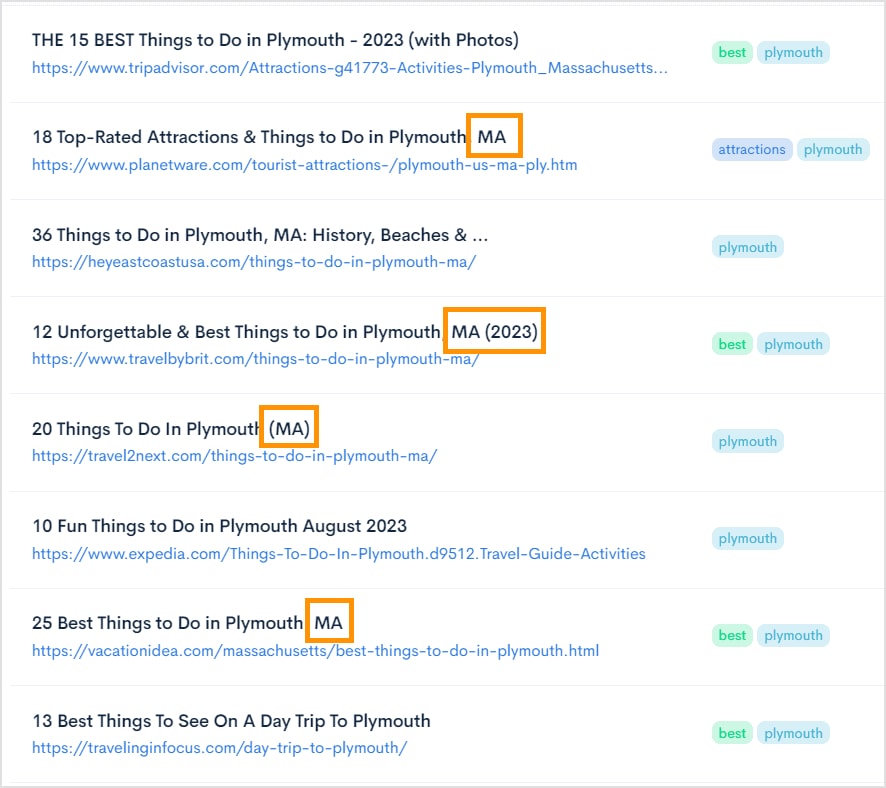
You can also check if there are any buyer intent keywords that lead to product pages. While this isn’t the case for our example, it would be beneficial for an eCommerce business looking to unlock more revenue.
3. Check for SERP Features
Next, we want to know if any of our keywords have SERP features. This includes featured snippets, rich results, etc.
In our example below, we see a keyword with a featured snippet on Google. (Unfortunately, it’s not one of the keywords we’d target because there are no weak spots.)

Featured snippets are displayed at the top of Google’s organic results in what SEOs call “position zero.”
This type of search results aims to answer the user’s question directly on the SERP.
4. Evaluate Competitors’ Content
At this stage, we want to learn about the ranking competitors’ content.
Some questions we should consider include:
- What is the average word count of the competing content?
- Have they optimized for this specific keyword?
- Does the content align with the search intent?
- How relevant are the websites for this kind of keyword?
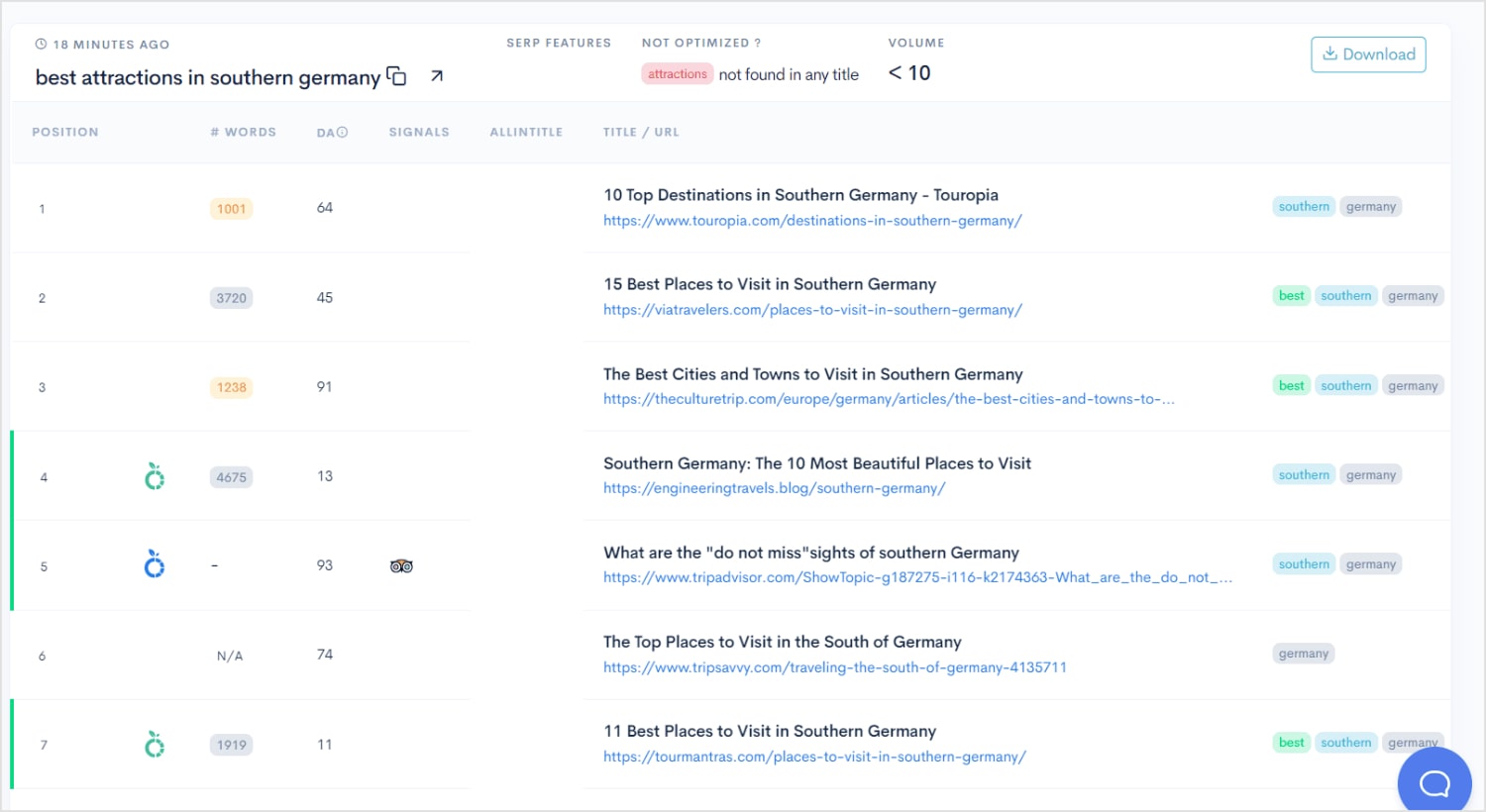
Using LowFruits to analyze one of our prospective content ideas, we can see that:
- The average word count is around 2,000, with low DA websites writing around 4,000 and high DA websites producing around 1,000-word articles
- No website on the 1st page has included the exact keyword ”best attractions in southern germany”.
- The competing articles are fairly relevant for this query and they most likely dedicated their content towards answering this query.
These insights suggest that our new travel website could very likely rank between the 3-7th position by covering the topic more in-depth than the competition as well as optimizing the title.
5. Check for Any Other SERP Signals
Finally, there are other SERP signals to look for when evaluating the search results. These include:
- Are the top-ranking websites forum pages or user-generated content?
Earlier, we discussed that there is a higher probability to outrank these pages, despite their high DA, since they are not very optimized.
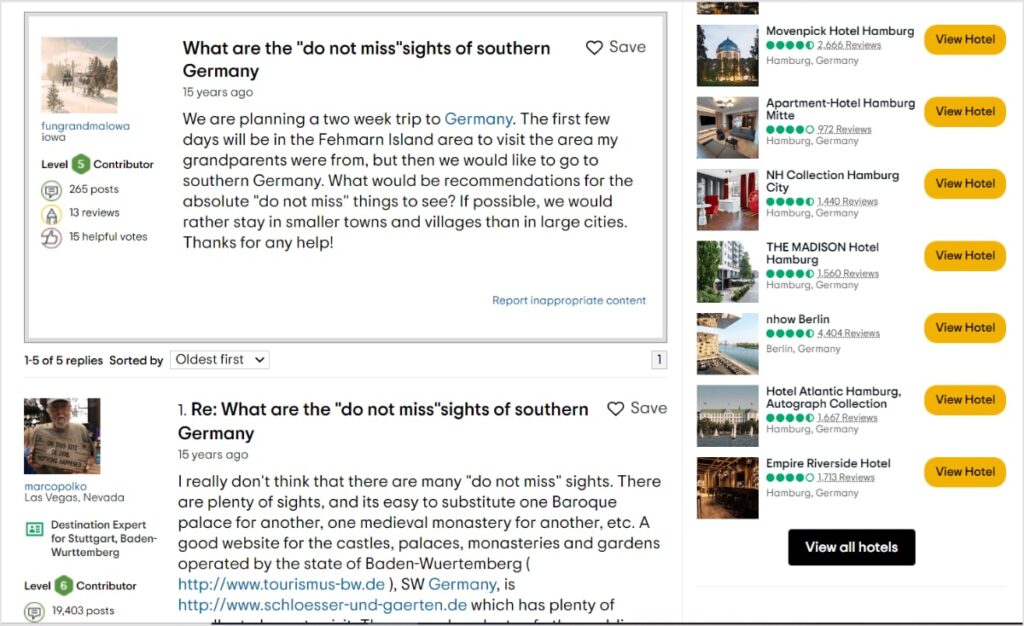
It’s possible to outrank this forum page by producing structured and useful content for the readers.
- Is the query location-specific?
Keywords could have the obvious ”uk” or ”usa” at the end, but some keywords could have ”nl” at the end, which would stand for ”Netherlands”
- Is the query with navigational intent?
When you are researching a foreign market, it’s important to know the local brands. It could be retailer websites such as Tesco or Walmart, or it can be more subtle, such as “chanel boots”.
“Boots” as in not shoes, but as a retailer of cosmetics.
In the example below, there’s mixed intent, so search engines serve results for both.
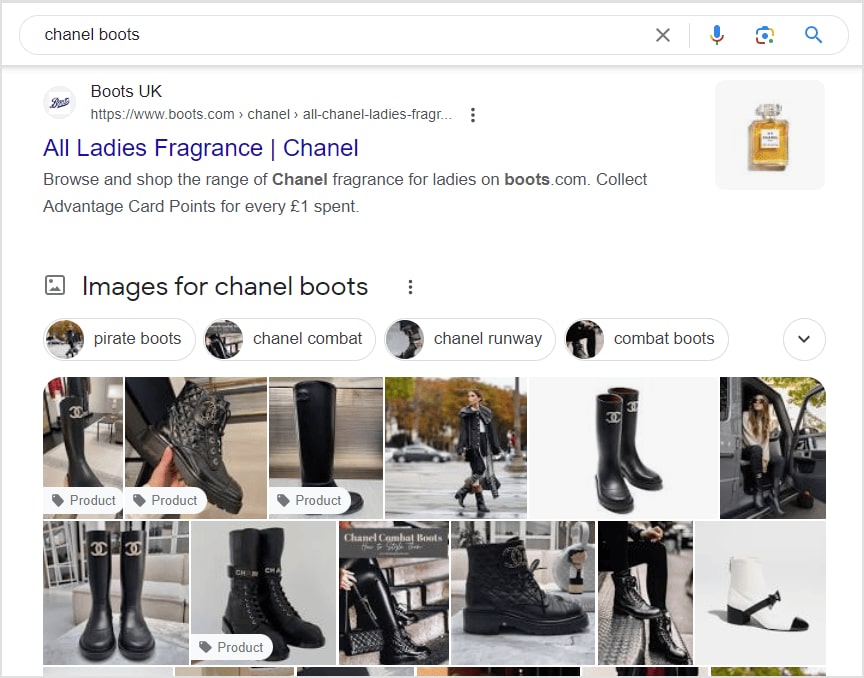
SERP Analysis Examples: Should We Target These Keywords?
That was our SERP analysis process.
In this section, we’ll walk through 3 keywords, analyzing the SERP for each and evaluating which ones to pursue.
For our examples, we’ll imagine we have a small bike shop and are looking to start a blog.
Here are some keywords we’re interested in:
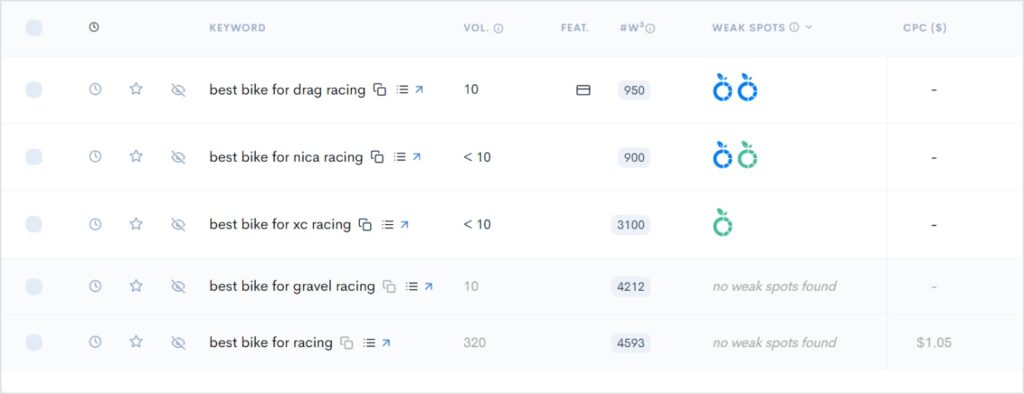
Example 1: “best bike for nica racing”
After analyzing the keywords with LowFruits, we can see that “best bike for nica racing” has 2 weak spots, aka websites ranking on the 1st page that our small bike shop would be able to beat.
One of them is a forum page ranking on 4th position, which means we could look to optimize our content better than it to outrank it.

Now, we want to see what the competitive landscape actually looks like on the SERP:
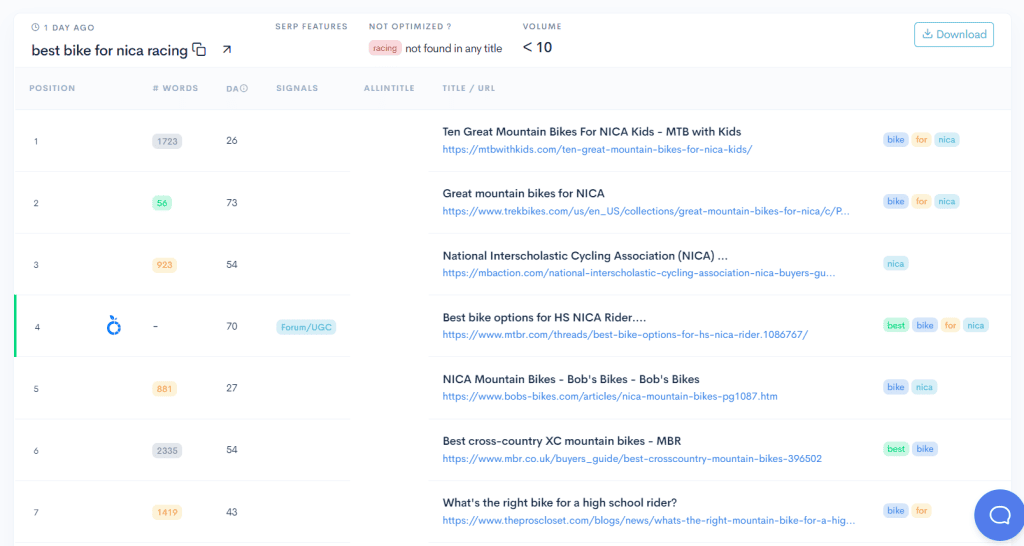
We could see that there is no particular dominant content type in the SERPs, as we can see both product pages and listicles ranking in the top positions.
The average word count for this query is 900, and we can see that pages that wrote over 2,000 words didn’t do much better.
That means we could combine a listicle with a product page by creating an article with multiple bikes and then positioning our bike as the best value-for-money option.
We could also see that the exact keyword does not seem to appear in any of the titles, which would further give us a ranking boost since we are most accurately targeting the topic.

Unfortunately, for this topic, there is no featured snippet, but that’s not a big problem. We were still able to see that we have realistic chances of breaking the top 3 for this query, even as a newer website.
We were able to spot a forum page on the 4th position and a low-word-count product catalog in the 2nd position, which means we should be able to break the top 3.
As for the relevancy of the ranking content, we’re in an even better position than the competition.
Here are the top pages for our keyword:
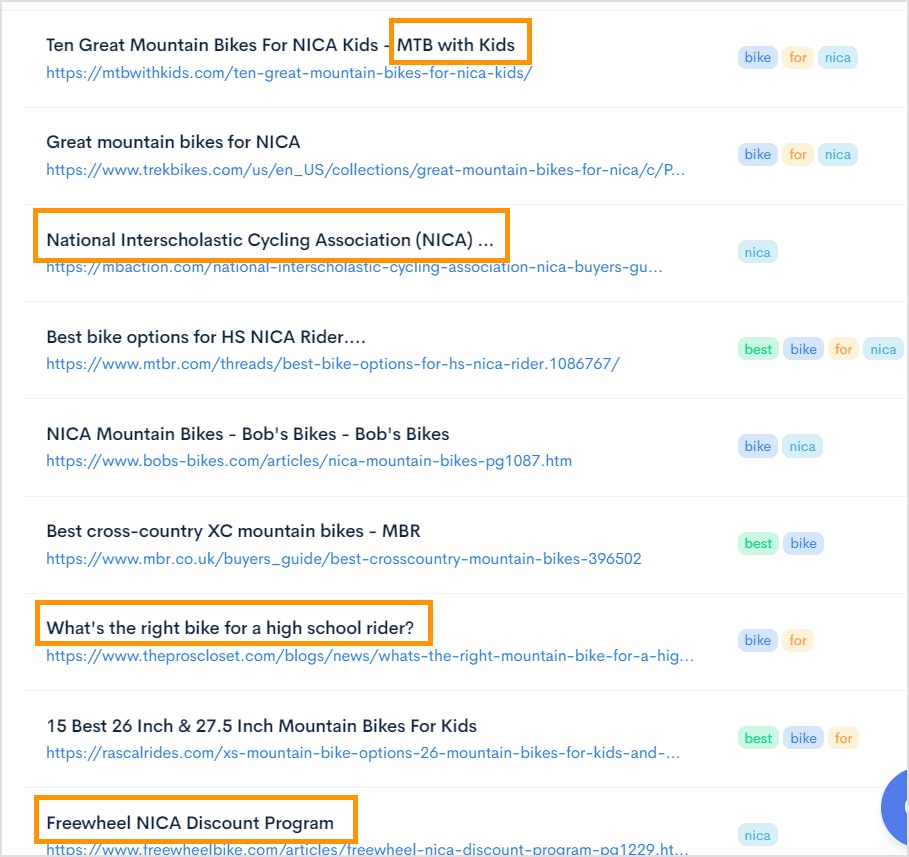
The first result discusses mountain bikes for kids, the third result is unrelated to the topic of bikes, and the seventh position covers regular bikes for high school.
Additionally, there’s a NICA discount program featured.
Given the limited competition and low content relevance to the main query, this keyword is worth pursuing.
VERDICT: We can target this keyword with confidence.
Example 2: “best bike for gravel racing”
When we start to evaluate this keyword, we can already see that LowFruits hasn’t found any weak spots on the SERPs.
That means every website that ranks on the first page in Google has some authority.

Upon further analysis, we can see that the top websites that are ranking have over 75 DA, and most of the competitors have written extensively on the topic.
There is a clear dominant content type, listicle content, but the competing websites have optimized for the main keyword.
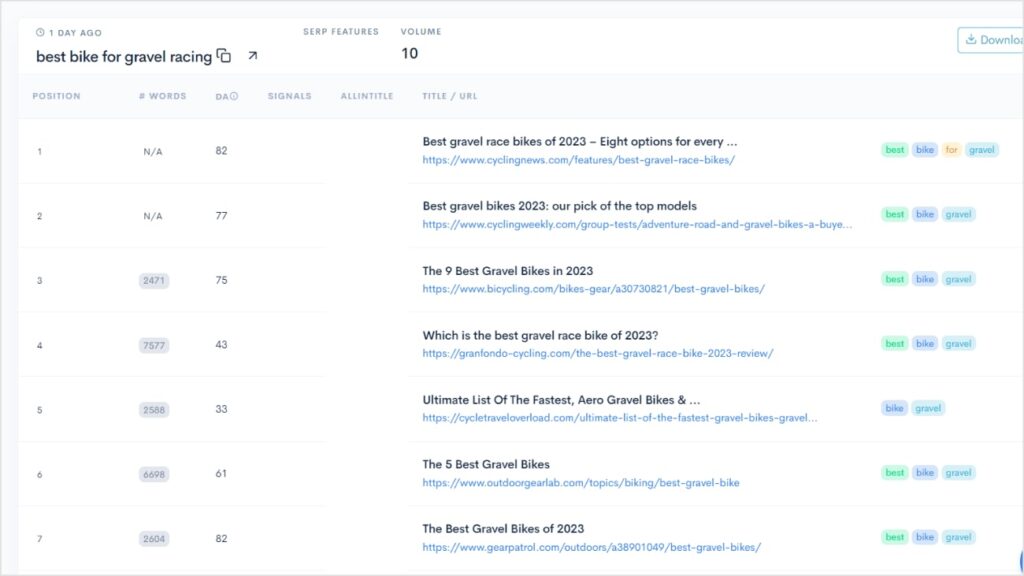
The competitor articles have relevant titles and content and high domain authority.
Additionally, these authoritative websites specialize in the bike niche.
In essence, we’ve likely lost this contest from the outset. While we could create content, it may take years to reach the first page and match their authority.
VERDICT: We should not pursue this keyword, as this article idea would be too hard to rank for.
Example 3: “best bike for drag racing”
For this keyword, we can see that there are 2 forum websites ranking on the 1st page, 1 of which is in 3rd position.

We can also see that it has an opportunity for a featured snippet and that the average word count is 950 words.
As we dive deeper into the competitors on the SERPs, we can see that a website with a DA of 29 is ranking in 1st position, and the forum we spotted earlier is in the 3rd position.
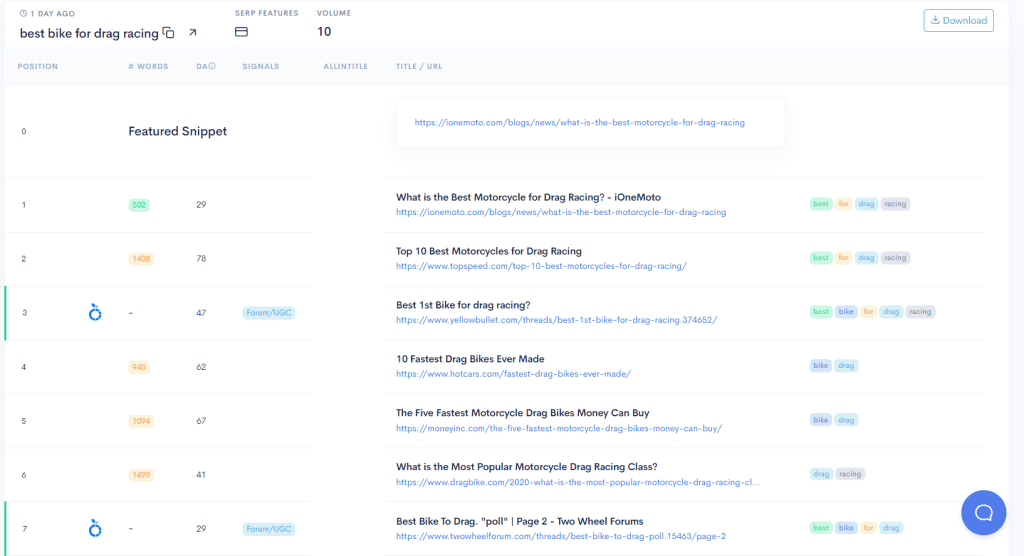
The dominant content type is listicles, and competitors have optimized properly for this keyword.
Word count, in this case, seems to matter. Articles over the average word count rank higher than others with more thin content, but the 1st result is an outlier.
The reason behind the first result’s success is the article’s relevancy to the topic. The other queries include:
- Motorcycles
- 1st Bike
- Fastest Drag Bikes
- Most popular
But in this case, the search intent reveals that users are searching for the best bike for drag racing. It doesn’t have to be the fastest, the most popular, or the 1st one.

For this reason, we are going to pursue this topic.
We’ll need to produce an article that covers the search intent better than our medium-level competitors.
Even in the face of authoritative websites, Google would prioritize content that answers the search query better than high-DA websites.
VERDICT: We’ll pursue this keyword by better aligning our content with the search intent than the competition.
Example 4: “best bike for xc racing”
Looking at our next keyword, we see a website ranking in the 9th position that we could overtake due to its low domain authority.

Even though that sounds promising, we’re dealing with a low-volume keyword (<10 volume/mo), which means that the 9th position isn’t very intriguing.
After closely analyzing the SERPs and the competition, we see that the average word count hovers around 3,000.
The website in the 1st position also has content well over 2,000 words.
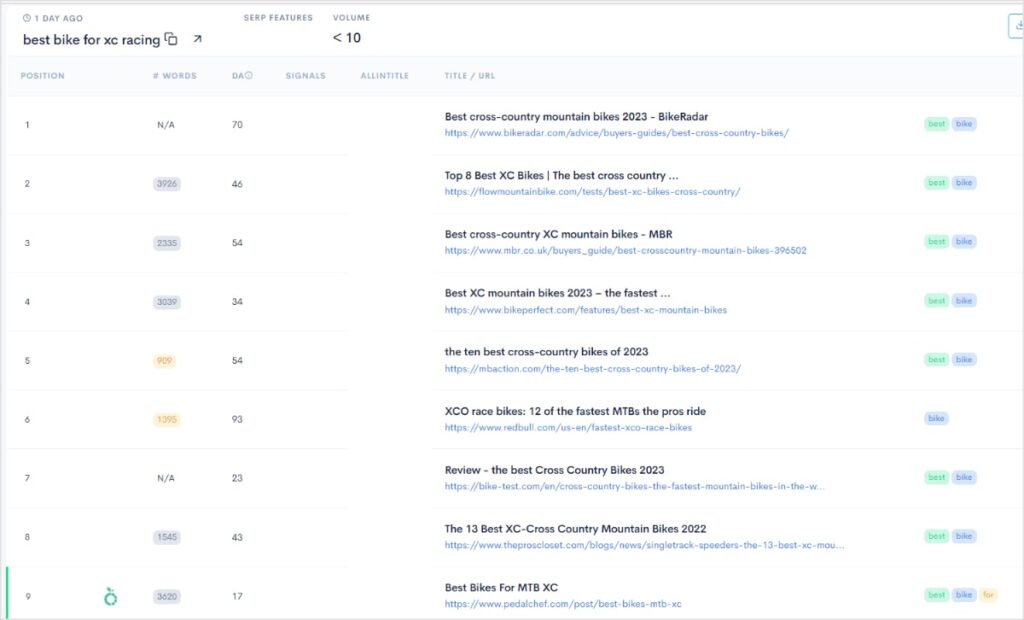
The competition is made up of websites with medium-to-high domain authority, and they seem to have covered the topic extensively and accurately with their listicle content.
But the reason why we’re not pursuing this keyword is because it’s not worth the effort.
At best, we would be able to rank at the bottom of the first page by covering the topic as extensively as everyone else (3,000+ words).
But for a keyword that has less than 10 searches per month, the bottom of the first page doesn’t sound like something that would be worth such a large content piece.
VERDICT: We will not pursue this keyword because the efforts far outweigh the potential reward.
Final Thoughts & Key Takeaways
Knowing how to do a SERP analysis is immensely valuable to your SEO and business goals. I hope the above tutorial and real-world examples gave you a clear picture of how to perform one yourself.
Here are a few key takeaways from this article:
- A SERP analysis is the process of evaluating if a website can rank for a specific keyword or topic.
- There are plenty of keywords that we can’t rank for, at least not easily, and that’s fine. You should prioritize creating content on topics you can realistically rank for.
- Carefully weigh effort versus reward when evaluating which keywords to target. Even if you can rank for a keyword in the 7-8th position, it might not be worth your time if it’s high effort and low search volume.
- Tools such as LowFruits can help you analyze the SERPs in bulk and save you time from doing it manually.